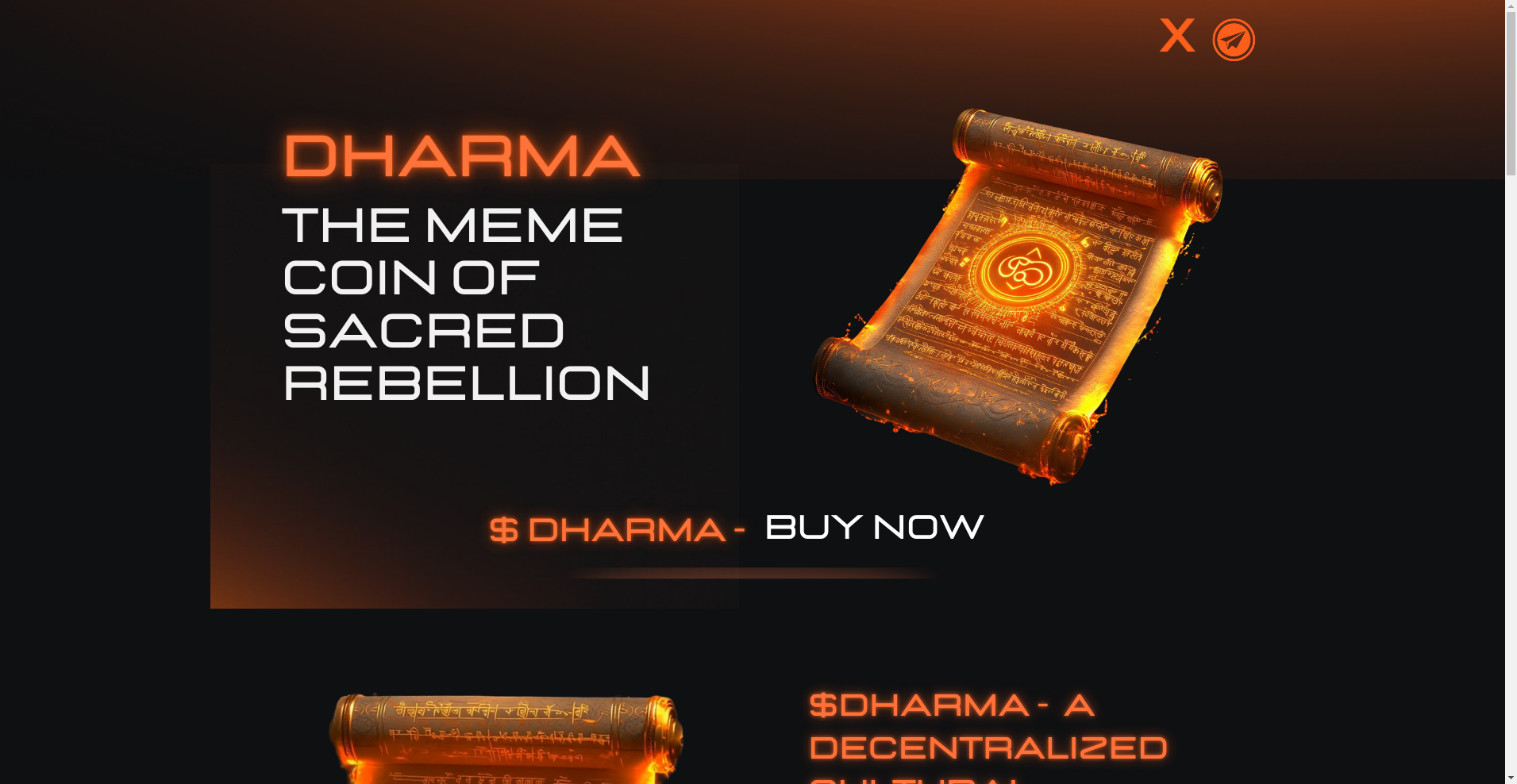Dharma ($DHARMA) Review: A Data-Driven Look at Its Legitimacy, Risks, and Long-Term Potential

What Is Dharma: An Introduction
Founded on the premise of merging cultural preservation with blockchain technology, Dharma (ticker: $DHARMA) is branded as "The Meme Coin of Sacred Rebellion." Unlike typical meme tokens, Dharma presents itself as a decentralized movement centered around the revival and protection of Sanatana Dharma—the eternal spiritual tradition of Hinduism. Its core mission emphasizes cultural mobilization through memes, funding real-world temples, Sanskrit education, and heritage revival initiatives, all governed via an on-chain treasury and DAO.
This project combines spiritual symbolism with blockchain mechanics, positioning itself as a "digital yajna"—a sacred offering meant to restore and amplify the ancient, sacred principles of Dharma in a modern, meme-driven context. Its narrative appeals strongly to community members motivated both by cultural preservation and the speculative allure of meme tokens. This review aims to impart an objective, evidence-based assessment of Dharma's legitimacy, strengths, and potential risks, grounded in available technical, security, and economic data.
The Team and Roadmap Evaluation
Assessing the credibility of Dharma begins with understanding the team behind it. The available data does not specify the identities or backgrounds of the founders or core developers. The absence of transparent team info raises questions about accountability and long-term commitment, which are critical factors in evaluating legitimacy.
The project's roadmap mentions various intended milestones—such as leveraging community engagement, funding real-world projects, and maintaining a decentralized governance model. While specific timeframes or detailed deliverables aren't outlined publicly, some key milestones include:
- Token launch with 108 billion tokens (a sacred number)
- Ownership renounced and liquidity burned
- Integration with decentralized governance via DAO
- Funding mechanisms for temples, Sanskrit learning, and heritage projects
The absence of detailed, timelined deliverables makes it challenging to verify the team’s capacity for execution. While the inclusion of tokenomics features like ownership renouncement and liquidity burn indicates thoughtful design, these alone do not confirm project sustainability or strong leadership. Overall, Dharma appears to be more community-driven without clear evidence of a seasoned or transparent development team.
Assessing Dharma Security and Trustworthiness
All publicly available security assessments for Dharma originate from a Cyberscope audit, which is a reputable source for smart contract analysis. According to the audit report, Dharma’s token contract underwent an evaluation; however, it flagged a significant issue:
- High-criticality vulnerability identified in the audit iteration. Specifically, the audit notes “high criticality” issues that could potentially compromise contract security if exploited.
Beyond this major finding, the audit indicates that the smart contract was deployed with measures like zero tax, renounced ownership, and a burned liquidity pool, which generally enhance user trust. The project also verified RugCheck, reducing the likelihood of a rug-pull. The community score and security score—respectively 64 and 95—are moderate to high, suggesting the project has taken some security precautions but remains susceptible to certain vulnerabilities.
While the audit’s flagged vulnerabilities warrant caution, the project’s emphasis on transparency—such as verified audits—implies a foundational level of security. Nevertheless, potential investors should understand that a high-criticality vulnerability, if not mitigated, can threaten contract integrity, especially if further security audits are not forthcoming or comprehensive.
A Breakdown of Dharma Tokenomics
Understanding the economic structure of $DHARMA is vital to assessing its sustainability and potential risks. With a total supply of 108 billion tokens, Dharma’s tokenomics draw heavily on religious symbolism, but the economic model itself appears to follow typical meme coin principles.
- Total Supply: 108,000,000,000 tokens, a sacred number symbolizing spiritual completeness in Dharma.
- Token Utility and Governance: The token is intended to fund real-world initiatives like temples and Sanskrit education through an on-chain treasury governed by a DAO. Holders are encouraged to be "digital warriors" supporting the movement. This treasury management is crucial for the project's long-term success.
- Ownership & Liquidity: Ownership has been renounced; liquidity has been burned, reducing centralized control and potential for rug-pulls.
- Vesting & Distribution: Details about team allocations, vesting, or early investor slices are currently unspecified, raising questions about long-term token utility and inflation control.
- Inflation/Deflation Mechanics: No explicit mention of token burning beyond the initial liquidity burn; therefore, inflationary risks persist if new tokens are minted or if token utility diminishes.
This economic model centers around a fixed supply with token utility linked to cultural and real-world impact. However, the lack of details on vesting and ongoing token issuance could pose risks related to inflation or devaluation. Additionally, reliance on community governance without clear safeguards might lead to centralization risks or governance abuses over time.
Assessing Dharma's Development and Ecosystem Activity
Current development activity appears limited, with no recent major updates or milestones publicly announced beyond the initial token launch and audit. The lack of visible on-chain activity—such as transaction volume, active wallets, or project updates—suggests that Dharma may still be in early stages or primarily driven by community hype rather than active deployment.
Social media metrics, such as approximately 6,500 Twitter followers and an active Telegram group, indicate a modest but growing community. Nonetheless, community size alone cannot substitute for demonstrable development progress or real-world adoption. For projects centered on cultural and spiritual missions, tangible progress—like temple partnerships or educational programs—is crucial for long-term credibility. Currently, Dharma’s ecosystem appears more aspirational than operational, pending concrete deployment metrics and real-world traction.
The Fine Print: Analyzing Dharma's Legal and Terms Framework
Based on available information, there are no explicitly stated terms and conditions that raise immediate legal concerns. The project emphasizes decentralization, renounced ownership, and token security, which are positive signals. However, the project’s website and documentation do not mention comprehensive legal disclaimers, investor protections, or clear jurisdictional statements.
Potential risks include the absence of legal clarity on how funds are managed, accountability mechanisms, or dispute resolution pathways. As a project with a spiritual and cultural mission, transparency around rights, governance, and legal compliance would be beneficial. The lack of detailed terms means investors should exercise caution, especially regarding fund management and governance processes, once the project begins to execute on its objectives.
Final Analysis: The Investment Case for Dharma
Overall, Dharma presents itself as a culturally motivated, community-driven blockchain project aiming to intertwine spirituality with modern decentralization principles. Its emphasis on transparency features like ownership renouncement and verified audits lend some credibility. However, the significant vulnerability flagged in the audit, the opaque development status, and the lack of detailed leadership transparency highlight notable risks.
From a risk-reward perspective, Dharma is speculative and primarily driven by community enthusiasm and ideological appeal. Its long-term sustainability hinges on real-world impact, ongoing development, and security improvements. Presently, it may offer opportunities for cultural engagement rather than assured financial returns. As with any project in the crypto space, due diligence—including understanding the security posture, the development roadmap, and community momentum—is essential before considering investment.
-
Pros / Strengths
- Unique cultural and spiritual branding that differentiates it from typical meme coins
- Decentralized governance with ownership renounced and liquidity burned, reducing centralization risks
- Verified security report and relatively high security score
- Community engagement via social channels like Telegram and Twitter
- Clear emphasis on funding real-world dharmic projects
-
Cons / Risks
- Limited information on the core team or founders
- Major security vulnerability flagged in the audit that could be exploited
- Development activity and ecosystem engagement appear limited or nascent
- Lack of detailed tokenomics, vesting, or governance safeguards
- Potential legal and regulatory ambiguities due to minimal transparent disclosures
In conclusion, Dharma is an ambitious project blending culture, spirituality, and blockchain, but it currently exhibits several red flags typical of early-stage or community-driven crypto initiatives. Investors should weigh its noble mission against the technical vulnerabilities and the transparency gaps before deciding on involvement. An informed approach—prioritizing security, clear leadership, and tangible progress—is vital when evaluating projects like Dharma.

Sarah Wilson
Offensive Security Engineer
I'm a professional "white-hat" hacker. I think like an adversary to find holes in crypto projects before the bad guys do. My job is to break things so you don't get broken.
Similar Projects
-
$BUCKET
Comprehensive Review of $BUCKET: Is This Solana Meme Coin a Scam or Legitimate? Crypto Scam Checker & Review
-
LUSD
Crypto Project Review & Scam Checker: Is LUSD Legit or a Scam? | Comprehensive Crypto Review
-
LYNO
In-Depth Review of LYNO Crypto Project | Scam Checker & Risk Analysis
-
ONI.exchange
Comprehensive Review of ONI.exchange: Is This Crypto Project a Scam? | Crypto Scam Checker & Review
-
Fluxtra
In-Depth Review of Fluxtra: Crypto Scam Checker & Project Scam Review